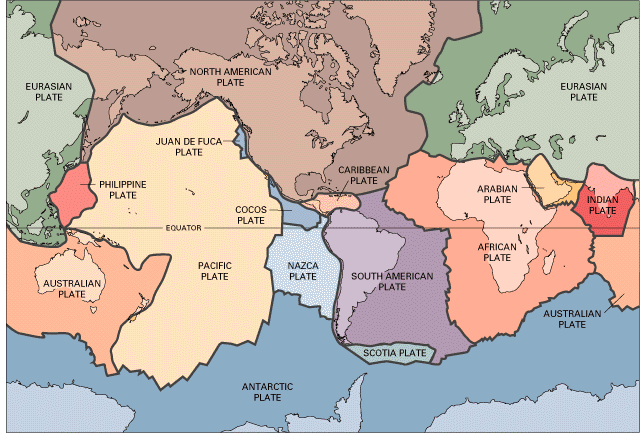
British Columbia Institute of Technology
Department of Civil Engineering
Unit 1: Earthquakes
Seismicity of British Columbia
Objectives
Upon successful completion of this unit students will be able to:
- explain the nature and the causes of earthquakes;
- identify regions of high seismic risk on the global scale;
- discuss the seismicity of Canada and British Columbia, and
- use the parameters for measuring earthquakes, such as earthquake magnitude and intensity.
The Nature of Earthquakes
Shaking motion of an earthquake is the result of a sudden release of energy. An earthquake occurs when stress, building up within rocks of the earth's crust, is released in a sudden jolt. Rocks crack and slip past each other causing the ground to vibrate. The slippage emits large amounts of energy in the form of waves that travel through the interior of the earth and across the surface, similar to the waves emanating from a stone dropped into a still pond. An excellent animated story on earthquake waves has been developed by PBS.
Cracks along which rocks slip are called faults; these may break through the ground surface, or remain deep within the earth. San Andreas fault, which stretches for more than 900 km along the coast of California, is shown on the figure below. This fault lies along the boundary between the Pacific Plate and the North American tectonic plate (tectonic plates are discussed in the next section). Activities of this fault have caused some of the major earthquakes in the United States and the world, such as the 1906 San Francisco earthquake (magnitude 8.3 on the Richter scale, killed 700 people and left 250,000 people homeless).

Depending on the relative layout of the rock blocks that move relative to each other in an earthquake and the direction of their relative movements, there are several types of faults. Some of the most common types of faults are: normal fault, reverse fault and strike-slip fault.
Normal Fault. In a normal fault, the block above the fault moves down relative to the block below the fault. This fault motion is caused by tensional forces and results in extension.
Reverse Fault. In a reverse fault, the block above the fault moves up relative to the block below the fault. This fault motion is caused by compression forces and results in shortening. A reverse fault is called thrust fault if the dip of the fault plane is small.
Strike-Slip Fault. In a strike-slip fault, the movement of blocks along a fault is horizontal. The fault motion of a strike-slip fault is caused by shearing forces.
Click here to view illustrative animations of the various fault movements.
The location on a fault where slip first occurs is called the focus, whereas the position directly above it on the ground is called the epicenter. Focus of an earthquake and the types of propagating seismic waves (surface waves, "S" waves and "P" waves) are illustrated on the figure below.
Focal depth is the distance between the focus and the epicenter, whereas distances of a site from the epicenter and focus are known as epicentral and hypocentral distances, respectively.

Stress that causes an earthquake is created by a movement of almost rigid plates, called tectonic plates, which fit together and make up the outer shell of the Earth (also called Earth's crust). These plates float on a dense, liquid layer beneath them. The plates move at such a slow rate (approximately the same rate as a fingernail grows) that the motion is not perceptible. For instance, Juan de Fuca plate off the coast of British Columbia moves only up to 5 cm/year relative to North American plate. Over time, however, this small movement can build up enough stress to produce significant earthquakes. A map illustrating the various tectonic plates that constitute the surface of the earth is shown on the figure below. Note that the western coast of Canada is located at the boundary between two large plates, i.e. the Pacific Plate and the North American Plate (and a small plate called Juan de Fuca plate).

Earthquakes occur most frequently on or near the edges of the plates where stress is most concentrated; such earthquakes are called interplate earthquakes. However, a significant number of earthquakes, including some large and damaging ones, do occur within the plates; these earthquakes are known as intraplate earthquakes.
Earthquakes can strike any location at any time. But history shows they occur in the same general patterns year after year, principally in three large zones of the earth. The world's greatest earthquake belt, the circum-Pacific seismic belt (also called "The Ring of Fire"), is found along the rim of the Pacific Ocean, where about 81 percent of the world's largest earthquakes occur. The belt extends from Chile, northward along the South American coast through Central America, Mexico, the West Coast of the United States, and the southern part of Alaska, through the Aleutian Islands to Japan, the Philippine Islands, New Guinea, the island groups of the Southwest Pacific, and to New Zealand. This earthquake belt was responsible for 70,000 deaths in Peru in May 1970, and 65 deaths and a billion dollars' damage in California in February 1971.
The second important belt, the Alpide, extends from Java to Sumatra through the Himalayas, the Mediterranean, and out into the Atlantic. This belt accounts for about 17 percent of the world's largest earthquakes, including some of the most destructive, such as the Iran shock that took 11,000 lives in August 1968, and the Turkey tremors in March 1970 and May 1971 that each killed over 1,000. All were near magnitude 7 on the Richter scale.
The third prominent belt follows the submerged mid-Atlantic Ridge. The remaining shocks are scattered in various areas of the world.
Go to next page Seismicity of Canada and British Columbia


